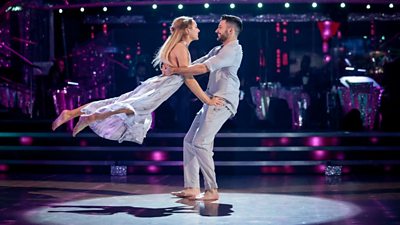Pauline Mason: ‘Big fat cow’ is the first sign See Hear’s presenter Yvonne Cobb teaches us. Video producer Kevin McGregor and I are used to working on bilingual shoots for Language Services and Partnerships but filming British Sign Language (BSL) is a new skill for the hearing members of the team. The signs for ‘fat cow’ and ‘thin giraffe’ are to help Kevin frame the shot, Yvonne explains, to make sure the camera captures every sign in full.
We’re at a contributor’s home in Oxfordshire making a film but also making 91Èȱ¬ News history. The film, about the explosion in interest in BSL following the popularity of Rose Ayling-Ellis on Strictly Come Dancing, is the first to be presented by a deaf female reporter.
The idea for the film was pitched to the News Commissioning Group by See Hear’s producer, Camilla Arnold. My role was to oversee the commission and ensure it was made, inclusively, for as many News outlets and audiences as possible.
Although hearing, my sister has been signing since childhood. On the eve of my first shoot, she told me that facial expressions are just as important as hands in signing. So, when Yvonne pointed out that the recommended clear facemasks were useless due to fogging up, I contacted our safety team and redrafted our Covid risk assessment instantly: daily negative lateral flow tests for everyone, open doors and windows, social distancing of at least a metre and… no facemasks for Yvonne, our deaf contributors or their interpreters.
Camilla, although unable to be on location, insisted on the importance of ‘deaf eyes’ when filming for deaf and signing audiences. Having Yvonne check key shots in the viewfinder allowed us to take creative risks. For example, our two contributors signing ‘good luck, Rose’ in darkness with only the TV as their key light, or a complicated mirror set-up shot of Yvonne. Even more important was Yvonne’s ability to share her enthusiasm for the expressiveness of sign language with 91Èȱ¬ audiences.
Camilla Arnold: It’s not just an exciting time for representation of deaf people on television and sign language. With Rose on Strictly Come Dancing, Hollywood films such as A Quiet Place 2, CODA and Sound of Metal featuring lead deaf characters, it is also an exciting time for deaf television. This year also marks the 40th birthday of See Hear, making it the oldest programme in the world for the deaf community.
Pauline Mason, UK News Commissioning and Camilla Arnold, 91Èȱ¬ See Hear, talk about making 91Èȱ¬ News history and celebrate 40 years of broadcasting for the deaf community. Since its formative years, the series brings the key issues of the day to the deaf community, which was particularly important in the days before the internet, email and text messaging. See Hear was particularly crucial during the early days of lockdown where the lack of a sign language interpreter present at the prime minister’s Covid briefings meant that the hundreds of thousands of deaf people did not have access to important information and so See Hear was the ‘go to’ place for information on the vaccine programme, the nature of Covid-19 and the work of frontline workers.
‘FAT COW, THIN GIRAFFE’ – AND CELEBRATING 40 YEARS OF 91Èȱ¬ SEE HEAR From left to right: Pauline Mason (producer), Kevin McGregor (video journalist), Molly Jordan (contributor), Maddie Peacey (contributor), Adrian Bailey (interpreter), Yvonne Cobb (presenter). To this day, people have watched See Hear religiously for the last 40 years and it is at the very core of the UK’s deaf community. See Hear records milestones in deaf history, highlights the issues we face and above all, shines a light where other mainstream programmes very rarely venture. It is still a trailblazing series. And it is our hope that the sign language commission for News is just the start of a more inclusive way of working.

